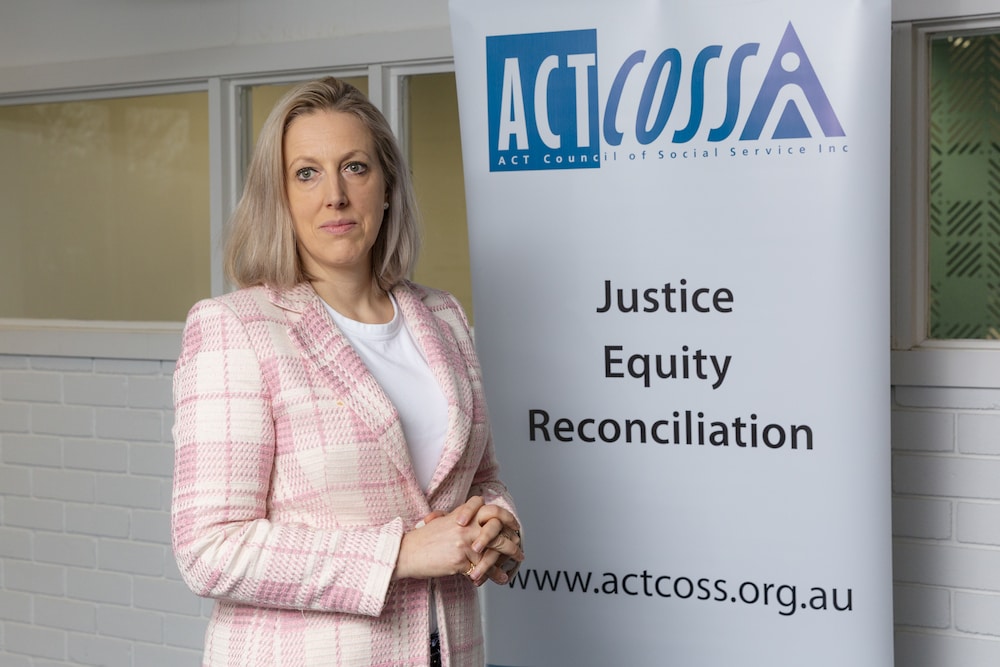Twelve months after the lockdown began, Dr Emma Campbell, CEO of the ACT Council of Social Service (ACTCOSS), says that the cost of living situation continues to worsen. But she believes the ACT government and the community sector can and should work together to solve the problem, as they did during the height of the pandemic.
Last year’s lockdown was announced the same day ACTCOSS published its 2021 Cost of Living Report, which showed that 9 per cent of Canberrans live below poverty, and that cost of living is increasingly unaffordable for low income Canberrans. In May, the 2022 Cost of Living Report showed Canberra experienced the biggest increase in the cost of living in 20 years.
“Our 2022 Cost of Living Report indeed lays bare the stark reality Canberrans are facing – high prices of everyday items and utilities, high rent, and extremely high demand for housing,” Dr Campbell said.
- Cost of living too high for many Canberrans, ACTCOSS reveals (13 August 2021)
- Canberrans on low incomes hit hardest by cost of living rises: ACTCOSS (6 May)
- Opinion: Cost of living tells a tale of two Canberras (14 May)
“Inflation continues to rise, with the CPI recording its largest annual rise since the year 2000.
“Despite the high averages, (the median weekly income for a single Canberran is $1,203 (2021 census) and is one of the highest in Australia), Canberrans on low incomes are being left behind.
“People on low incomes spend a much greater proportion of their income on the basics – rent, transport, utilities, healthcare, foods – where we’ve seen the highest rises in costs and they have little or no discretionary income to use to cover those higher costs. That means that they go without – parents feed the kids and go without themselves. Older people don’t heat or cool their home, and get sick; people with chronic health issues go without a visit to the doctor or don’t fill a prescription. All of this leads to poor health and well-being outcomes.”
The lockdowns themselves, Dr Campbell believes, were a “painful but necessary” public health measure to protect the most vulnerable people in our community, including older people, people with disability, people with chronic health conditions – “until we understood the best infection control measures, and until vaccinations were widely available and rolled out”.
“The ACT Government should be acknowledged for the excellent work they did to achieve a world-leading take up of vaccinations across our community,” she said.
An important part of this, she thinks, was the partnership between the ACT Government and the community sector through the ACT Equity to Access vaccination program that enabled isolated and vulnerable communities to receive appropriate information and to build sufficient trust to make the decision to be vaccinated.
However, while Dr Campbell considers the response to the COVID-19 pandemic, including lockdowns, necessary, she notes that people’s incomes, relationships and physical situations were placed under duress as the ACT went into a long lockdown.
- ACTCOSS: Poverty after COVID restrictions end (9 November 2021)
As a result, community organisations have seen a significant increase in demand as a result of COVID.
For example, during the lockdown, demand for mental health services increased significantly; Lifeline Canberra reports a 40 per cent increase in demand for its services.
Domestic and family violence services, and community legal services all saw significant increases in demand, which continue until now, Dr Campbell said.
“The lockdown and COVID-19 crisis also showed the fragility of our housing situation,” Dr Campbell said.
In January 2022, the Report on Government Statistics showed that over the previous year:
- The ACT had the highest rate of rental stress for lower-income private renters of any Australian jurisdiction (73 per cent compared with 50 per cent nationally)
- The number of public housing dwellings in 2021 is below the number in 2012 (10,950) and the peak in 2018 (11,181)
- There are 164 fewer households in social housing in the ACT in 2021 compared to 2020, and this number is lower than a decade ago in 2012 (11,328) and its peak at 11,435 households in 2017
- More than 30 per cent of clients who approached homelessness services with a need for accommodation did not have their needs met.
But the COVID-19 pandemic also showed how we can tackle poverty, Dr Campbell argues.
The ACT poverty rate dropped from a pre-COVID estimate of 8.6 per cent to 5.2 per cent by October 2020 when the Coronavirus supplement, Jobseeker and Youth Allowance significantly increased, and the number of recipients in the ACT more than doubled during the first part of the COVID-19 epidemic in 2020.
When JobKeeper and the Coronavirus Supplement were withdrawn, however, the poverty rate in the ACT increased to approximately 9.0 per cent: an estimated 38,300 Canberrans – including approximately 9,000 children – by the time of the second lockdown.
“The lockdown showed that the ACT community sector and the ACT Government can work together to provide creative solutions to challenging problems,” Dr Campbell said.
“The successful delivery of these programs, such as the Equity to Access program, shows that when we work closely and flexibly and invest sufficient resources, we can come up with solutions that enable the most vulnerable Canberrans to access the services and supports they need and deserve. We need to repeat this on other issues and challenges.”
More in this series:
- Emma Davidson: ACT lockdown ‘burned into my memory’ (12 August)
- Canberra businesses face post-lockdown challenges (15 August)
- Many ACT businesses still recovering from 2021 lockdown (16 August)
- Lockdown protected ACT community, says Chief Health Officer (16 August)
- Lifeline: Canberrans more willing to discuss mental health (19 August)
- Five forward steps for small businesses in a post-lockdown Canberra (22 August)



